- Research
- Core Facilities
- Institutional Core Facilities
- Molecular and Genomics Core Facility
Molecular and Genomics Core Facility
Facilities and Equipment
The University of Mississippi Medical Center (UMMC) Molecular and Genomic Core Facility (MGCF) is located on the 3th floor (G352-353) of Guyton Building and occupies approximately 1500 sq. ft. of laboratory space. The core facility is well-equipped to perform genomic analysis on human and a number of model organisms, including rat and mouse. The core facility is experienced in all aspects of molecular biology, including isolation of nucleic acids, quality control, next generation sequencing (NGS), gene-editing technologies, and bioinformatics analysis.
Specific equipment housed in the core facility include:
Storage of biological samples, including:
4 X -80ºC freezer, 4 X -20ºC freezer and 2 X 4°C refrigerators.
Sample processing, nucleic acid isolation, quality control systems, and automation including:
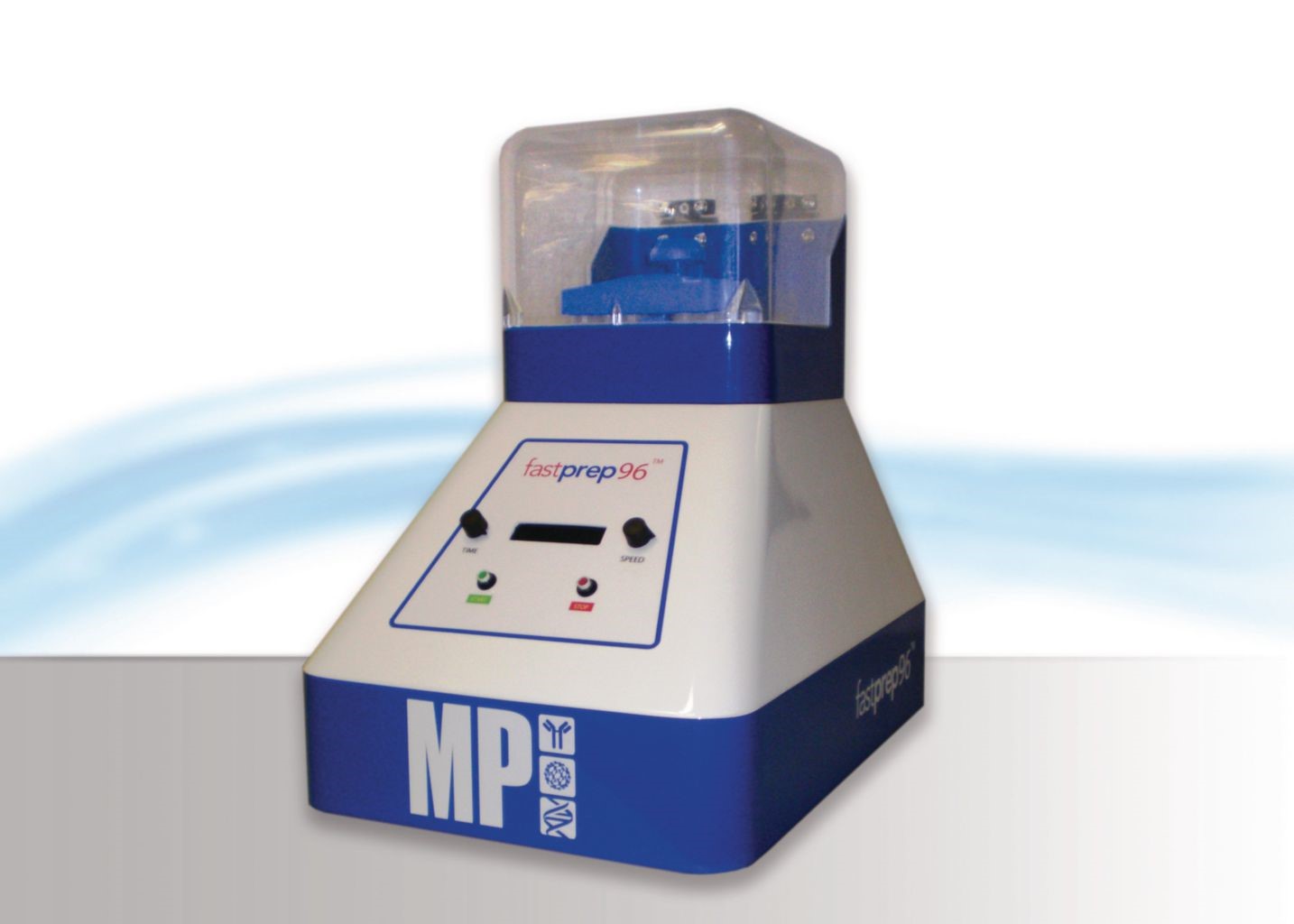
- MP Biomedical FastPrep®-96 instrument. The FastPrep system is used to homogenize biological samples. Itprovides high-throughput processing (192 samples simultaneously in 2 x 96 deep well plates) of tissues and cells. The processed samples can then be used with KingFisher Flex instrument to quickly, easily and reproducibly isolate stable RNA, active proteins and full-length genomic DNA.
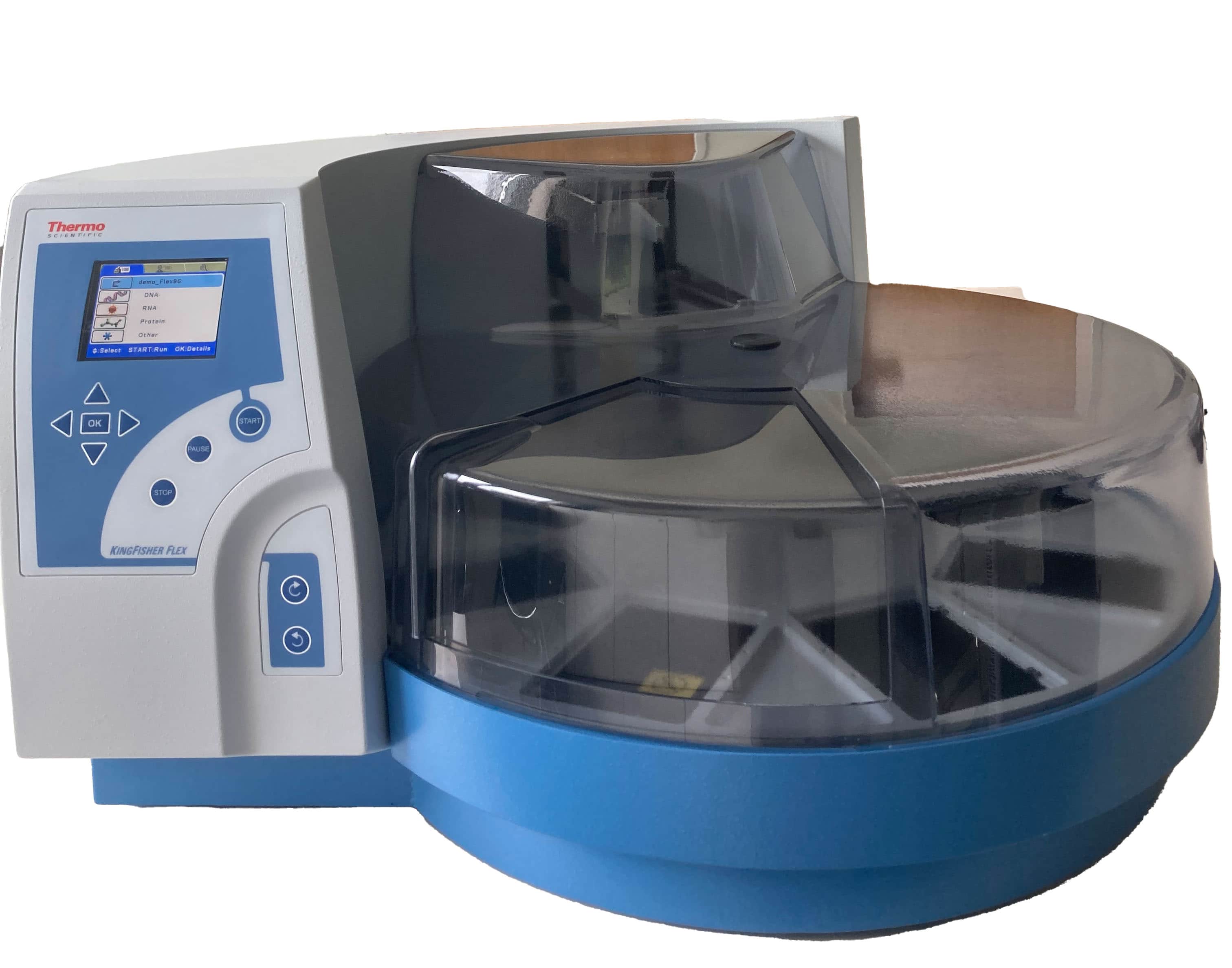 KingFisher™ Flex Magnetic Particle Processors- 96 and 24 head: The KingFisher Flex Magnetic Particle Processor is for DNA/RNA, protein or cell purification from virtually any source. This system comes with a fully automated high purification of nucleic acids, proteins and cells, a system which system can process up to 96 samples in under 20 minutes with additional flexibility that allows the use any of magnetic particle-based kit to meet various application demands.
KingFisher™ Flex Magnetic Particle Processors- 96 and 24 head: The KingFisher Flex Magnetic Particle Processor is for DNA/RNA, protein or cell purification from virtually any source. This system comes with a fully automated high purification of nucleic acids, proteins and cells, a system which system can process up to 96 samples in under 20 minutes with additional flexibility that allows the use any of magnetic particle-based kit to meet various application demands.- NanoDrop™ ND-1000 and NanoDrop™ Microvolume UV-Vis Spectrophotometer, and Qubit Fluorimeter. These spectrophotometers allow micro level quantitation of only 1ul of sample with high reproducibility. This allows researchers to measure samples up to 50-fold higher in concentration than can be measured on classical 1 cm curette-based systems, virtually eliminating the need for dilutions. The NanoDrop™ One instrument recent upgrade provides more accurate determination of quantity and quality of DNA, RNA, and protein samples in seconds with only 1-2 µL, including full-spectral data. This instrument offers more dynamic range (0.2- 27,500 ng/ul dsDNA), greater wavelength range (190- 850 nm), and higher spectral resolution. The Qubit Fluorimeter is fluorescent based system. DNA or RNA concentration is reported by a fluorescent dye that emits a signal only when bound to the target, which minimizes the effects of contaminants—including degraded DNA or RNA.
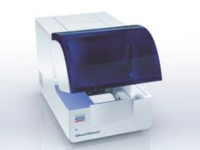 QIAxcel Advanced System. The QIAxcel Advanced system provides high-throughput RNA and DNA analysis (up to 96 samples) using capillary based gel system. It allows for more efficient quality control of RNA and will serve as a replacement for standard agarose gel electrophoresis genotyping of PCR products. Thus, for most genotyping, the preparation of agarose gels, ethidium bromide staining, and image analysis will no longer need to be done. Additionally, the system can be configured to automatically call genotypes.
QIAxcel Advanced System. The QIAxcel Advanced system provides high-throughput RNA and DNA analysis (up to 96 samples) using capillary based gel system. It allows for more efficient quality control of RNA and will serve as a replacement for standard agarose gel electrophoresis genotyping of PCR products. Thus, for most genotyping, the preparation of agarose gels, ethidium bromide staining, and image analysis will no longer need to be done. Additionally, the system can be configured to automatically call genotypes.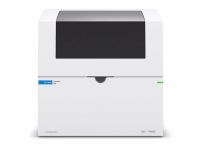 Agilent 4200 TapeStation. The Agilent TapeStation allows for automated quality control (QC) analysis of DNA and RNA samples. The TapeStation is an all-in-one platform (instrument, software, and data processing/analysis) that can analyze nucleic acids for sample size, quantity, and integrity. In particular the instrument is completely scalable from the analysis of a single sample up to 96 with data generation within minutes for a few samples or 90 minutes for full 96 samples. This type of system is vital to genomic core technology and integral to performing all next-generation sequencing (NGS) workflows including initial QC of nucleic acids, QC of adapter ligated and amplified NGS samples, and ultimately assessment of pooled libraries before running on sequencing instrumentation (iSeq10, NextSeq1000, NextSeq2000, and Singular Genomics G4). The Agilent system is more flexible and has a greater limit of detection of nucleic acids concentration detection compared to the QIAxcel Advanced System.
Agilent 4200 TapeStation. The Agilent TapeStation allows for automated quality control (QC) analysis of DNA and RNA samples. The TapeStation is an all-in-one platform (instrument, software, and data processing/analysis) that can analyze nucleic acids for sample size, quantity, and integrity. In particular the instrument is completely scalable from the analysis of a single sample up to 96 with data generation within minutes for a few samples or 90 minutes for full 96 samples. This type of system is vital to genomic core technology and integral to performing all next-generation sequencing (NGS) workflows including initial QC of nucleic acids, QC of adapter ligated and amplified NGS samples, and ultimately assessment of pooled libraries before running on sequencing instrumentation (iSeq10, NextSeq1000, NextSeq2000, and Singular Genomics G4). The Agilent system is more flexible and has a greater limit of detection of nucleic acids concentration detection compared to the QIAxcel Advanced System.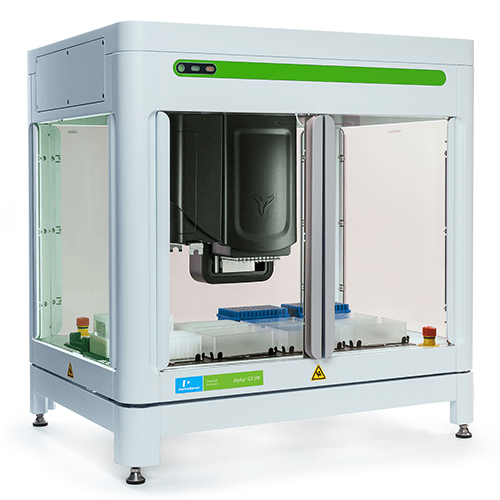 Two Perkin Elmer Zephyr G3 NGS Workstation. The Zephyr® G3 NGS Workstations are benchtop liquid handlers designed to automate library preparation for next generation sequencing and address laboratory requirements for the physical separation of pre and post-PCR processes. The graphical user-interface and standardized deck with integrated hardware maximizes laboratory productivity while reducing variability resulting from manual pipetting steps. The workstations offer a walk away solution and flexible processing enabling the parallel processing of 8-96 NGS library or exome preparations or a 96-well plate of SPRI size selections / post-PCR clean-ups per run.
Two Perkin Elmer Zephyr G3 NGS Workstation. The Zephyr® G3 NGS Workstations are benchtop liquid handlers designed to automate library preparation for next generation sequencing and address laboratory requirements for the physical separation of pre and post-PCR processes. The graphical user-interface and standardized deck with integrated hardware maximizes laboratory productivity while reducing variability resulting from manual pipetting steps. The workstations offer a walk away solution and flexible processing enabling the parallel processing of 8-96 NGS library or exome preparations or a 96-well plate of SPRI size selections / post-PCR clean-ups per run.
Medium throughput genetic/ genomic analysis instrumentation, including:
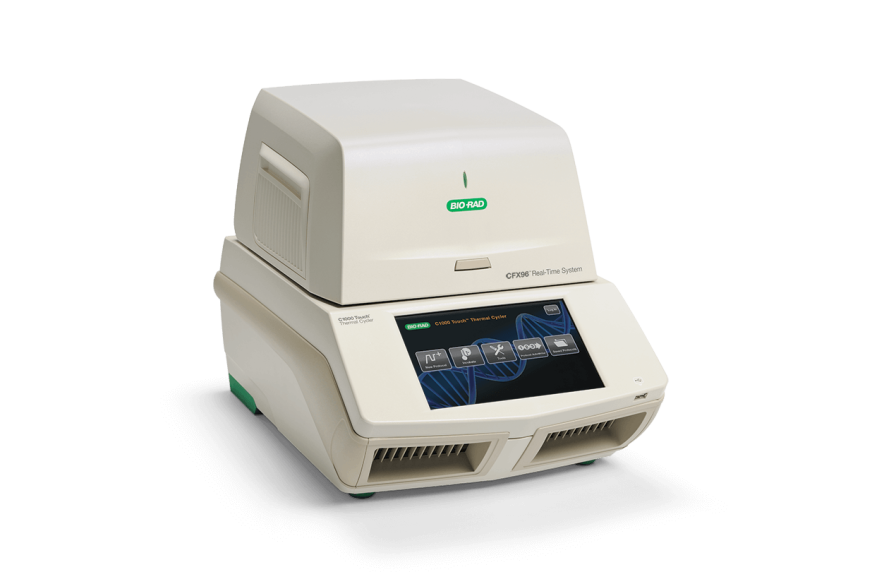 Bio-Rad CFX96™ and Bio-Rad CFX384™ real-time PCR detection systems. These systems provide medium -throughput platform (n=1-384 samples) to perform gene expression/ quantitative real-time PCR. These systems allow for quick set-up of runs and monitor amplification traces in real time on the integrated LCD touch screen. The CFX384 allows up to five-target detection and easy-to-use software to calculate fold-change between sample groups.
Bio-Rad CFX96™ and Bio-Rad CFX384™ real-time PCR detection systems. These systems provide medium -throughput platform (n=1-384 samples) to perform gene expression/ quantitative real-time PCR. These systems allow for quick set-up of runs and monitor amplification traces in real time on the integrated LCD touch screen. The CFX384 allows up to five-target detection and easy-to-use software to calculate fold-change between sample groups.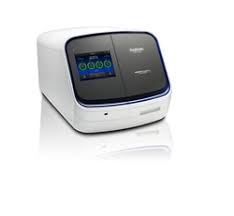 SeqStudio Genetic Analyzer. The Applied Biosystems SeqStudio Genetic Analyzer is a 4-capillary, fluorescence-based capillary electrophoresis system designed to provide an integrated easy, efficient, and versatile solution sequencing needs. This instrument complements our NGS instruments by providing cost-effective sequencing for low-throughput samples, including plasmid validation, PCR products, and single variant/polymorphism analysis, and targeted methylation.
SeqStudio Genetic Analyzer. The Applied Biosystems SeqStudio Genetic Analyzer is a 4-capillary, fluorescence-based capillary electrophoresis system designed to provide an integrated easy, efficient, and versatile solution sequencing needs. This instrument complements our NGS instruments by providing cost-effective sequencing for low-throughput samples, including plasmid validation, PCR products, and single variant/polymorphism analysis, and targeted methylation.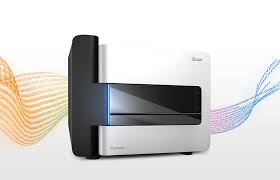 Illumina iScan System. This Illumina iScan offers array-based genotyping and DNA methylation analysis capabilities primarily for human studies and some model organisms, such as mice. The iScan instrument complements our current NGS capabilities by allowing us access to cost effective ways to analyze genome SNP genotyping as well genome-wide methylation. The iScan's compatibility with various Illumina microarrays and integration with powerful software tools further enhance UMMC's ability to accelerate genomics research and drive scientific advancements in understanding the complexities of the human genome. https://www.illumina.com/systems/array-scanners/iscan/specifications.html
Illumina iScan System. This Illumina iScan offers array-based genotyping and DNA methylation analysis capabilities primarily for human studies and some model organisms, such as mice. The iScan instrument complements our current NGS capabilities by allowing us access to cost effective ways to analyze genome SNP genotyping as well genome-wide methylation. The iScan's compatibility with various Illumina microarrays and integration with powerful software tools further enhance UMMC's ability to accelerate genomics research and drive scientific advancements in understanding the complexities of the human genome. https://www.illumina.com/systems/array-scanners/iscan/specifications.html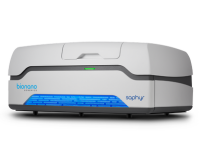 Bionano Genomics Saphyr. The Saphyr has an unmatched view of the genome because it utilizes optical genome mapping (OGM) to analyze ultra-high molecular weight DNA in its native state. It provides an unparalleled view of large-scale structural variations often missed by other methods. The Saphyr can detect a broader range of structural variants (SVs), including inversions, translocations, and copy number variations, down to 500 base pair resolution and 5% variant allele frequency.
Bionano Genomics Saphyr. The Saphyr has an unmatched view of the genome because it utilizes optical genome mapping (OGM) to analyze ultra-high molecular weight DNA in its native state. It provides an unparalleled view of large-scale structural variations often missed by other methods. The Saphyr can detect a broader range of structural variants (SVs), including inversions, translocations, and copy number variations, down to 500 base pair resolution and 5% variant allele frequency.
https://bionano.com/saphyr-systems/
- Applied Biosystems QuantStudio 7 Pro Real-Time PCR System.
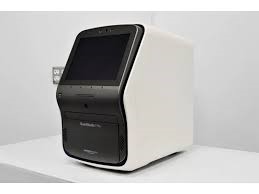 The Applied Biosystems QuantStudio 7ProReal-Time PCR System is an advanced, high-performance tool used for precise and reliable geneticanalysis. Designed for research and diagnostic applications, itenables accurate quantification of nucleic acids like DNA and RNA in real time. The system offers fast data collection, superior sensitivity, and intuitive software, making it ideal for tasks such as gene expression analysis, mutation detection, and genotyping. With its automated features and flexibility, the QuantStudio 7 Pro enhances lab efficiency while delivering trusted results for a wide range of molecular biology workflows.
The Applied Biosystems QuantStudio 7ProReal-Time PCR System is an advanced, high-performance tool used for precise and reliable geneticanalysis. Designed for research and diagnostic applications, itenables accurate quantification of nucleic acids like DNA and RNA in real time. The system offers fast data collection, superior sensitivity, and intuitive software, making it ideal for tasks such as gene expression analysis, mutation detection, and genotyping. With its automated features and flexibility, the QuantStudio 7 Pro enhances lab efficiency while delivering trusted results for a wide range of molecular biology workflows.
High throughput genomic analysis using next generation sequencing instrumentation, including:
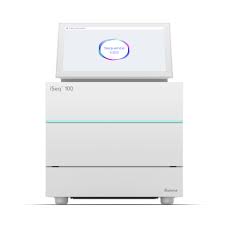 Illumina iSeq100 platform. The Illumina iSeq100 platform is a desktop sequencer that very versatile sequencing from 1 X36 bp up to 2 X 150 paired-end reads in a single run, generating 1.2 Gigabases (Gb) or up to 8 million sequencing reads in a single run. This can allow for performing amplicon sequencing, small genome sequencing and assembly, and enables detection of target variants with unmatched accuracy. https://emea.illumina.com/systems/sequencing-platforms/iseq/specifications.html
Illumina iSeq100 platform. The Illumina iSeq100 platform is a desktop sequencer that very versatile sequencing from 1 X36 bp up to 2 X 150 paired-end reads in a single run, generating 1.2 Gigabases (Gb) or up to 8 million sequencing reads in a single run. This can allow for performing amplicon sequencing, small genome sequencing and assembly, and enables detection of target variants with unmatched accuracy. https://emea.illumina.com/systems/sequencing-platforms/iseq/specifications.html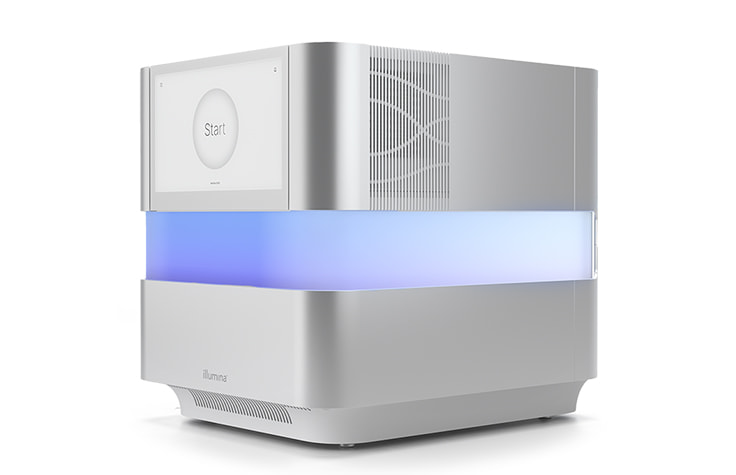 Illumina NextSeq2000 platform. The Illumina NextSeq200 is provides greater sequencing throughput compared to the NextSeq500 and NextSeq2000, including greater batching of human exomes, whole human genome, SARS-CoV2 genome sequencing, whole transcriptome analysis and single cell transcriptomics in a single run. The system is scalable and can run flow cells (P2) to generate similar amount of data compared to the NextSeq50, but more cost effectively as well as generate >300Gb or >2 billion reads in a single run using the P3 flow cells.
Illumina NextSeq2000 platform. The Illumina NextSeq200 is provides greater sequencing throughput compared to the NextSeq500 and NextSeq2000, including greater batching of human exomes, whole human genome, SARS-CoV2 genome sequencing, whole transcriptome analysis and single cell transcriptomics in a single run. The system is scalable and can run flow cells (P2) to generate similar amount of data compared to the NextSeq50, but more cost effectively as well as generate >300Gb or >2 billion reads in a single run using the P3 flow cells.
https://emea.illumina.com/systems/sequencing-platforms/nextseq-1000-2000/specifications.html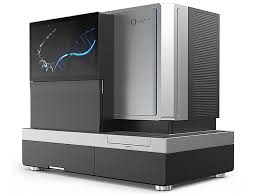 Singular Genomics G4 Sequencing Instrument. The G4 is similar to the Illumina instrument in generating short sequencing reads (up to 300 bases for each read). However. the unique features of the G4 instrument is that it provides the ability to run 1 -4 flow cells (allowing flexibility from project to project compared to a single flow cell for Illumina instruments), significant cost saving on flow cells, and most importantly the instrument has a unique way of increasing sequencing throughput specifically for 10X single cell libraries, which ultimately potentially up to 3 billion reads per run at significantly less cost compared to what it would be for Illumina. This is best advantage of the instrument as single cell genomics demand is growing and without an ability to generate more data at reduced cost.
Singular Genomics G4 Sequencing Instrument. The G4 is similar to the Illumina instrument in generating short sequencing reads (up to 300 bases for each read). However. the unique features of the G4 instrument is that it provides the ability to run 1 -4 flow cells (allowing flexibility from project to project compared to a single flow cell for Illumina instruments), significant cost saving on flow cells, and most importantly the instrument has a unique way of increasing sequencing throughput specifically for 10X single cell libraries, which ultimately potentially up to 3 billion reads per run at significantly less cost compared to what it would be for Illumina. This is best advantage of the instrument as single cell genomics demand is growing and without an ability to generate more data at reduced cost.
https://support.singulargenomics.com/faqs/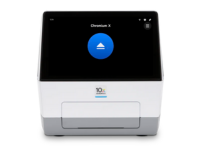 10X Chromium X. The 10X Chromium Instrument enables the capture of individual biomedical material, such as DNA fragments or whole cells within tens of thousands of uniquely addressable partitions, each containing an identifying barcode for downstream analysis. The most important utility of this instrument is to perform single cell RNA sequencing (scRNAseq). scRNAseq has become an important research tool (both for basic science and clinically) allowing for simultaneous transcriptome analysis on individual cells/different cell types derived from complex tissues as opposed to performing sequencing on RNA isolated from an entire piece of tissue or even cell-culture studies. For example, an entire organ (e.g. kidney, brain, etc.) can be harvested, digested into a single cell suspension, and sequencing performed on 100- 80,000 individual cells. An added benefit of this technology is that it fully integrates with our current Illumina sequencing equipment, including the Illumina NextSeq 2000. https://www.10xgenomics.com/instruments/chromium-x-series
10X Chromium X. The 10X Chromium Instrument enables the capture of individual biomedical material, such as DNA fragments or whole cells within tens of thousands of uniquely addressable partitions, each containing an identifying barcode for downstream analysis. The most important utility of this instrument is to perform single cell RNA sequencing (scRNAseq). scRNAseq has become an important research tool (both for basic science and clinically) allowing for simultaneous transcriptome analysis on individual cells/different cell types derived from complex tissues as opposed to performing sequencing on RNA isolated from an entire piece of tissue or even cell-culture studies. For example, an entire organ (e.g. kidney, brain, etc.) can be harvested, digested into a single cell suspension, and sequencing performed on 100- 80,000 individual cells. An added benefit of this technology is that it fully integrates with our current Illumina sequencing equipment, including the Illumina NextSeq 2000. https://www.10xgenomics.com/instruments/chromium-x-series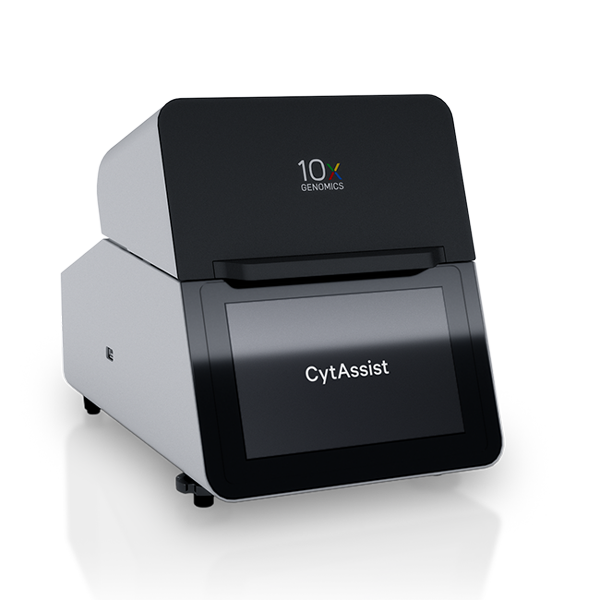 10X CytAssist. The CytAssist instrument was designed to streamline the preparation of single-cell suspensions for use in the Chromium system, particularly to enable spatial transcriptome analysis. The CytAssist offers automated and efficient cell sample preparation, which is crucial for achieving high-quality data in single-cell experiments. By enabling consistent and reproducible cell isolation and handling, the CytAssist helps researchers improve the accuracy and reliability of their single-cell studies, ultimately leading to more meaningful scientific discoveries.
10X CytAssist. The CytAssist instrument was designed to streamline the preparation of single-cell suspensions for use in the Chromium system, particularly to enable spatial transcriptome analysis. The CytAssist offers automated and efficient cell sample preparation, which is crucial for achieving high-quality data in single-cell experiments. By enabling consistent and reproducible cell isolation and handling, the CytAssist helps researchers improve the accuracy and reliability of their single-cell studies, ultimately leading to more meaningful scientific discoveries.
https://www.10xgenomics.com/instruments/visium-cytassist


